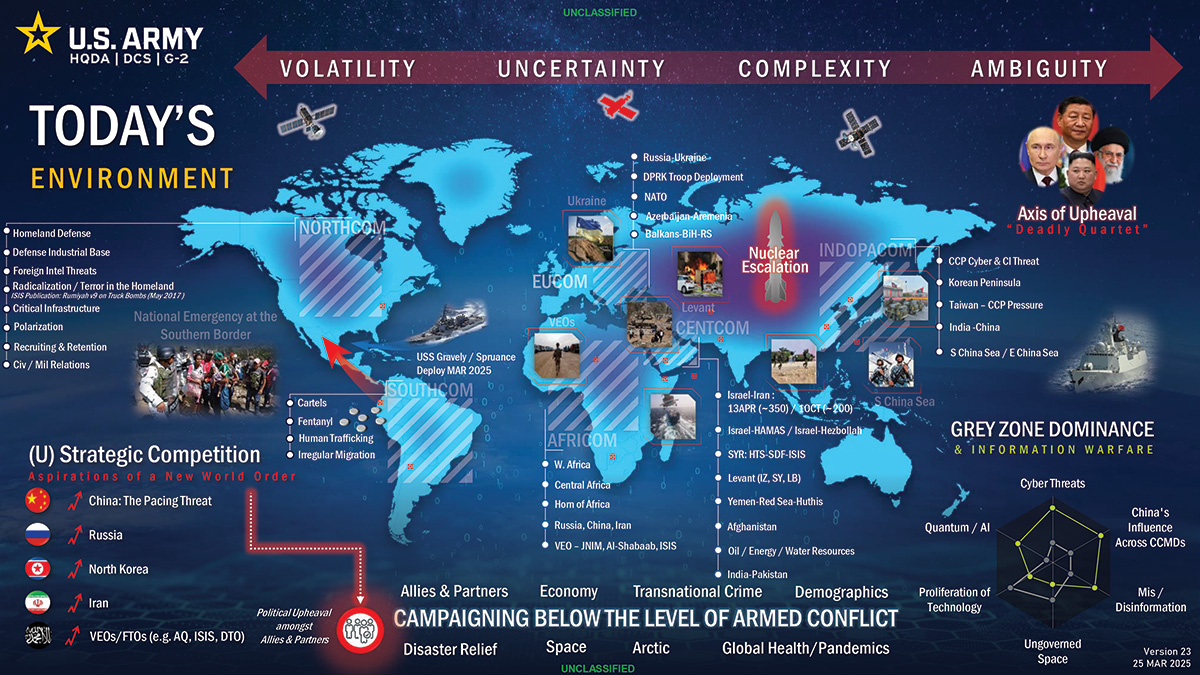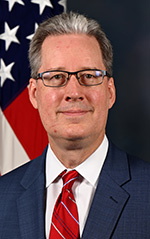State and Defense: Closer Than You Might Think
Reflections
BY ROBERT HILTON

Today’s geopolitical environment in which diplomacy and defense operate is depicted in this U.S. Army graphic.
U.S. Army
My two-year tour as foreign policy adviser (POLAD) to the chief of staff of the U.S. Army was what the Army would call a “broadening assignment.”
I returned to the Department of State with new skills, knowledge, and perspectives that will help me do my job better, to the department’s benefit.
I also acquired a deeper appreciation for how diplomacy and the military can collaborate to achieve our shared objectives—because our organizations are more similar than people think. Many—both inside the government and out—assume the gap between State and Defense is larger than it is. In my view, while there are differences, the similarities are greater.
The first notable difference is the kinetic option available to the military. In diplomacy, we lack the ability to achieve our goals through force. As a diplomat, I wouldn’t challenge a foreign minister to arm wrestle, nor would it be effective if I did. When diplomacy reaches its limits, when statecraft cannot resolve or deter a situation, policymakers may call on the military.
The Army’s fundamental purpose is to fight and win our nation’s wars. As a diplomat and an American, I am grateful that, if ordered to do so, the military has the potential to bend our enemies to our will.
As a diplomat, I wouldn’t challenge a foreign minister to arm wrestle, nor would it be effective if I did.
The second difference is one of scale. The Department of State often laments that there are more lawyers in the Department of Defense (DoD) than diplomats at State. Conversely, military members sometimes ask why their organizations are called on to perform functions that State or USAID might be doing. The short answer: resources. The sheer size of the military, and the Army in particular, allows it to achieve great things.
For example, when I became General James C. McConville’s POLAD in June 2022, he described for me the Army’s role in developing and distributing the COVID vaccine. I subsequently observed the Army establish mechanisms to channel billions of dollars in weaponry and training to Ukraine, build a floating pier off Gaza, and fix a bridge in Baltimore.
The Army accomplishes big deeds with its people and capabilities. State does a great job with the resources we have, but we can’t compete with the scope of the military.
What Brings Us Together
Our differences are, however, less important than what brings us together. First: our need for and concern for our people. I often heard U.S. Army Chief of Staff General Randy A. George, General James McConville’s successor, remind his senior team in the Pentagon to consider the impact on the soldier down range of every decision they made.
General McConville’s slogan, “People First,” encompassed active duty and reserve and National Guard, veterans, civilians, family members—all of whom make up the vast enterprise of the U.S. Army.
At State, we are beginning to think of all our different categories—generalists and specialists, Civil Service, locally employed staff, and our families—as one team, which is essential if we are going to work together to achieve our policy objectives.
And, of course, we all put our spouses and children and pets through the process of uprooting, moving, and replanting every few years over the course of two or three decades of service. Members of the military grapple with the same issues we do—schools for our children, employment for our spouses, elder care from continents away. Senior leaders must prioritize our people to enable both warfighters and diplomats to perform their duties effectively.
The Full Range of Challenges
Both institutions work within three common environments. First, we both operate in a resource-constrained environment. Again, I acknowledge the tremendous funding disparity between State and DoD, but neither organization receives enough taxpayer money to do all the things it is asked to do by policymakers. Trade-offs are unavoidable; it isn’t possible to do everything, everywhere, all at once.
Second, both organizations operate in the same challenging global arena for the same ends: protecting our nation and promoting our national interests and ideals. U.S. Army Deputy Chief of Staff for Intelligence Lieutenant General Anthony Hale created a slide to illustrate the volatile, uncertain, complex, and ambiguous environment in which the Army works (see above).
Diplomats address these same challenges. They are at work in volatile, uncertain, complex, and ambiguous physical and policy environments around the world, routinely dealing with hardship and danger.
Finally, and most important, diplomacy and the military are tools used by and subordinate to elected policymakers. The American people elect a president who appoints the Secretaries of State and Defense, and we are obligated to implement their decisions, whatever we may think.
At the State Department, we don’t have a phrase like “best military advice” (a phrase disliked by some in the military, I know), but we should. At least, that’s what we practice. We provide best diplomatic advice to elected and appointed leaders, who make decisions that we then execute, not always happily or comfortably, but professionally.
I rejoined State with increased admiration for the U.S. Army and a strong belief that we are on the same team, striving to achieve the same goals for our great nation.
When sharing or linking to FSJ articles online, which we welcome and encourage, please be sure to cite the magazine (The Foreign Service Journal) and the month and year of publication. Please check the permissions page for further details.


